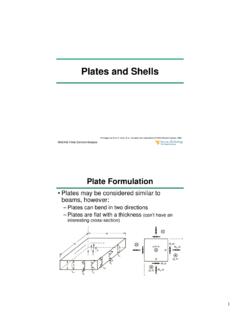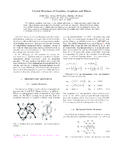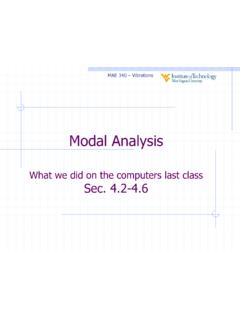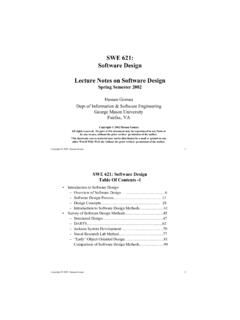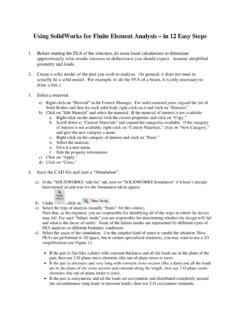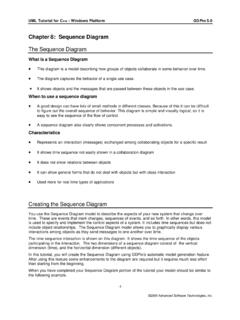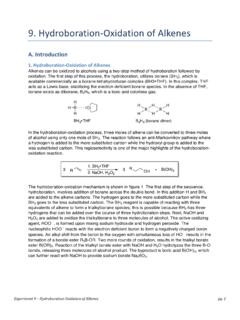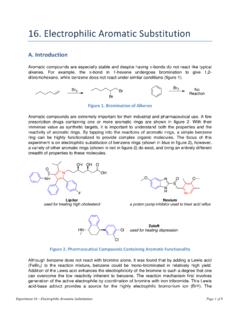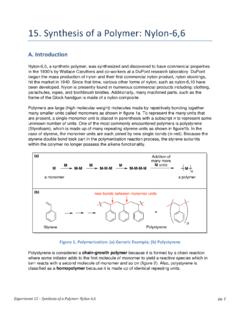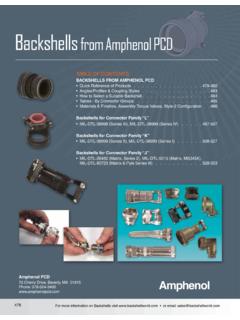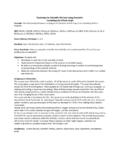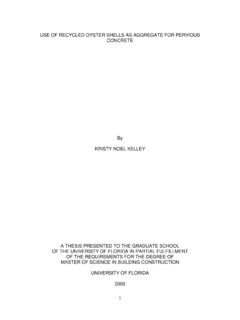Transcription of Plates and Shells - West Virginia University
1 1 MAE456 Finite Element AnalysisPlates and ShellsAll images are from R. Cook, et al. Concepts and Applications of Finite Element Analysis, Finite Element Analysis2 plate Formulation Plates may be considered similar to beams, however: Plates can bend in two directions Plates are flat with a thickness (can t have an interesting cross-section)2 MAE456 Finite Element Analysis3 Thin plate Formulation Consider a thin plate on the xyplane (z= 0), with thickness t, & neglecting shear strain. If we take a differential slice from plate :MAE456 Finite Element Analysis4 Thin plate Formulationthen: yz= zx= 0ywzvxwzuyxww = ==),( Assume z= 0.
2 Therefore:3 MAE456 Finite Element Analysis5 Thin plate Formulation These stresses give rise to moments: Maximum stresses are therefore given by:2max,2max,max,2max,6 ,6,2 since 6tMtMtztMxyxyyyxxxx== == MAE456 Finite Element Analysis6 Thin plate Formulation This is similar to the beam formula, but since the plate is very wide we have a situation similar to plain strain. For a unit width beam, flexural rigidity D=EI=Et3/12. For a unit width plate , flexural rigidity D=EI/(1- 2)=Et3/[12(1- 2)]. This thin plate theory is also called the Kirchhoff plate theory. 4 MAE456 Finite Element Analysis7 Mindlin plate Theory Mindlin plate Theory assumes that transverse shear deformation also Finite Element Analysis8 Mindlin plate Theory The deformations and strains are therefore given by:5 MAE456 Finite Element Analysis9 Mindlin plate Theory Mindlin plate elements are more common than Kirchhoff be the same shape functions as for Q4 and Q8 quadrilateral elements.
3 The displacement interpolation is given by:MAE456 Finite Element Analysis10 Support Conditions Support Conditions are similar to those for beams:For Mindlin Plates , do not restrain n, to avoid accuracy problems. n, Mn rotation and moment normal to edge s, Ms rotation and moment perpendicular to edge6 MAE456 Finite Element Analysis11 Test Cases For plate elements, patch tests and single element tests should include the cases shown:MAE456 Finite Element Analysis12 Test Cases plate elements must be able to show constant x, yand xyat each zlevel to pass a patch test. They must pass the test for constant Mx, Myand Mxy. Many element formulations perform poorly for these Finite Element Analysis13 Large Displacements and Membrane Forces A beam with fixed supports will exhibit string action axial forces as shown.
4 If we consider both string action and bending stresses, a beam can carry a distributed load of:MAE456 Finite Element Analysis14 Large Displacements and Membrane Forces A similar situation arises with Plates , however basic plate elements are not set up to handle membrane forces. If w/tis large ( , greater than ), a non-linear analysismust be performed using shell elements, which do handle membrane forces. In general, tensile membrane forces will have a stiffening effect and compressive membrane forces will decrease Finite Element Analysis15 shell Finite Elements shell elements are different from plate elements in that: They carry membrane AND bending forces They can be curved The most simple shell element combinesa bending element with a membrane element.
5 , combines a plate element and a plane stresselement. These elements are flat, therefore it is important that elements are not all coplanar where they meet at a node. MAE456 Finite Element Analysis16 shell Finite Elements Curved shell elements can be derived using shell theory. Isoparametric shell elements can also be obtained by starting with a solid element and reducing degrees of freedom. Thin shell behavior varies widely between formulations and should be tested before Finite Element Analysis17 Shells and shell Theory A thin shell structure can carry high loads if membrane stresses predominate. However, localized bending stresses will appear near load concentrations or geometric Finite Element Analysis18 Shells and shell Theory Localized bending stresses appear in many different situations:10 MAE456 Finite Element AnalysisShells and shell Theory A thin-walled cylindrical tank has high bending (flexural) stresses at the base.
6 Use a finer mesh where there are discontinuities or abrupt changes in the Finite Element Analysis20 Shells and shell Theory For a cylindrical shell of radius Rand thickness t, the localized bending dies out after a distance : Membrane stresses do not die Finite Element AnalysisUsing shell Elements to Model Beams To do a proper FE analysis, the analyst must understand how the structure is likelyto behave and how elements are ableto behave. In some cases it is more appropriate use shell elements rather than beam Finite Element AnalysisUsing shell Elements to Model Beams A curved I-beam reacts to moments as shown, therefore shell elements would be more accurate than beam elements.
7 Pipe bends react to moments as shown. Use shell elements or specialized beam elements with correction Finite Element AnalysisUsing shell Elements to Model Beams If the load is not applied directly below the shear center , the channel will twist. Use shell elements instead of beam Finite Element AnalysisUsing shell Elements to Model Beams If beam flanges are wide, x= My/I is not accurate. Beam elements will not give accurate results. In this case, plate / shell elements should be used.
